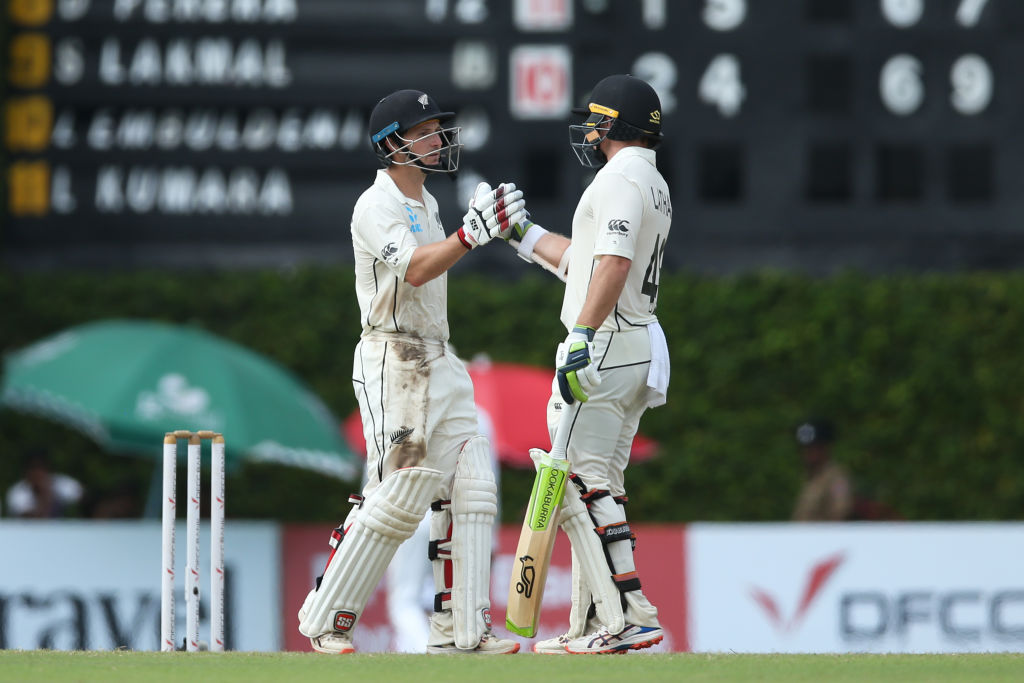New Zealand batsmen unlock first step towards redemption
New Zealand had made a few significant mistakes in the World Cup and yet they went on to “not lose” the final at Lord’s. However, they didn’t get to lift the trophy and the team has been in a quest for redemption ever since, the first beacon of which came about in Sri Lanka recently.

The Black Caps had arrived back home, from Melbourne, and were received as heroes despite facing a convincing defeat against Australia in the 2015 World Cup Final. The cheers at the airport, the pride of the fans reflected in the confident eyes of the World Cup finalists. There was no shame, no grief, no looking back. It was all about how far the team had come after having lost six World Cup semi-finals and finally winning one. The New Zealand team weren’t dark horses of World Cricket anymore, the moment they made it to the final history was rewritten and the Kiwis were seen as one of the best in business. A jinx was broken, and New Zealand once again made it to the final of the World Cup, four years later.
No other World Cup finalists ever left as big a mark as New Zealand did in the Lord’s final of 2019 and yet they didn’t get to lift the trophy. England’s right to the World Champions title will probably remain the most questioned victories of all time. While the home team celebrated all around the park with evidently overflowing joy, the equally deserving New Zealand team sat on the fence with their twinkling eyes reflecting their heavy hearts. The entire Cricket fraternity and more started a futile protest that screamed how Kane Williamson deserved to lift the trophy along with Eoin Morgan. But then came the most difficult part of being the “good guys”, they had to smile through the pain induced by a ridiculous rule. And so they did.
The valiant Black Caps walked back through the renowned Lord’s pavilion carrying the burden of their broken dreams. Ranked second in the world in the Test format, the Kiwis marched into their next assignment - the ICC Test Championship - with known enemies but on unfamiliar territory. Over the years New Zealand has been playing more and more games, across formats, against Sri Lanka. But the last time, the Kiwis toured Lanka was in 2012.
The first Test in Galle showcased the visitors’ batting woes, something similar to their 2019 World Cup campaign. Under Brendon McCullum, New Zealand had made it to the final undefeated. In the latest edition though, the team faced a lot of hiccups making it to the semis despite a great start. With leading batsmen like Kane Williamson, Ross Taylor and Tom Latham in the side, along with the highest run-scorer of the 2015 World Cup Martin Guptill, New Zealand were supposed to be one of the best batting units in the competition. But in reality, it was only Kane Williamson who rose to the occasion to save his team multiple times and with a net run rate excess over Pakistan, New Zealand were able to cement a place in the semis.
Throughout the tournament, the openers struggled to form a good partnership and provide a base to the batting. Simultaneously, left-handed top-order batsman, Tom Latham was underused down the order when his suited position was clearly at the top. Latham, who made his international debut in 2012, rose to prominence only in 2016 when he excelled in the sub-continent. He amassed 450 runs at 75 in 8 away matches that were played between India and New Zealand in 2016-17, all of them as an opener. Around that time, simultaneously, Latham was already the permanent opener for New Zealand in Tests. While his partners kept changing, from Martin Guptill to Jeet Raval, Latham continued to justify his position at the top and soon became the team’s one of the most reliable batsmen. Moreover, it was established that the mellow-eyed sturdy Tom Latham is a natural opener.
The fact that Latham was underused in the ICC mega event was no less than a sin, something that Williamson and the management might’ve realized far too late in the competition to bring about any changes. In 10 matches in the World Cup, Latham managed to amass only 155 runs at 19.37. But his natural strength as an opener was seen once again in the recently-concluded two-match Test series in Sri Lanka. Latham rose to the occasion, scoring a match-winning 154 off 251 in the Colombo Test, that New Zealand won by an innings and 65 runs, to help his team tie the series with the hosts.
While the first Test, in Galle, was won by Sri Lanka with a margin of 6 wickets, the match was actually more competitive than what the result would suggest. To most fans, it was a classic case of the team facing defeat when Williamson had failed to perform. But the captain, looked at the positives while admitting that they didn’t have a clear judgement of the situation. While New Zealand were able to restrict Sri Lanka at 267 in the first innings, with Ajaz Patel and William Somerville picking up five and three wickets respectively, the same bowlers majorly failed to defend a total of 260 in the 4th innings.
“We would have taken 260 as the target when we won the toss. The surface only slowed down and didn't deteriorate like in the past. It was a good surface. We probably batted reasonably well and didn't bowl well enough. There are a lot of positives from the game for us,” Williamson had said at the post-match presentation.
Despite what might’ve seemed to be a situation where the bowlers failed, it was actually the batting that was the difference between the two teams. Together Sri Lanka skipper Dimuth Karunaratne and Lahiru Thirimanne put up a partnership of 161 runs in the 4th innings chase and that’s what inflicted pressure on the bowlers. Eventually, a brilliant show of batting by New Zealand in the Second Test led to victory and there were more positives to focus on than just one, despite the fact that New Zealand had tied the series and not won it. Had they whitewashed Sri Lanka, the Kiwis would be holding the top position in the ICC World Test Championship Table. But as India defeated West Indies in the first Test in Antigua, they kept that position and New Zealand remained at No.2.
With the Ashes and India’s tour of West Indies being underway simultaneously with New Zealand’s tour of Lanka, the latter was bound to be overlooked. It was 5 years ago, a match between South Africa and the hosts when a Test match in Sri Lanka last saw a draw. Sri Lanka is known to produce results in Test Cricket - despite intermittent rain interruptions - and yet the drawn second Ashes Test drew more attention than the amazing cricket that was being played in the Asian Island. And it’s not just about the excess of Test matches happening simultaneously, for New Zealand it’s always the case due to the cruel play of timezones.
If there had to be a perfect victim of such ignorance, it has to New Zealand’s wicket-keeper batsman BJ Watling, who despite being the best in business around 2015-2016 was majorly underrated. Eventually, his form took a dip in the 2017-18 season but his redemption in Sri Lanka turned out to be series defining for New Zealand, a team that is only recognized when their captain Williamson performs well or breaks a record. Despite the availability of the statistics of cricketers being easily available online, the game of reputations has overshadowed the ability of excessively talented players like BJ Watling.

 Highest batting average of wicket-keeper batsmen since 2015(min 1000 runs and 30 innings) © ESPNCricinfo
Highest batting average of wicket-keeper batsmen since 2015(min 1000 runs and 30 innings) © ESPNCricinfoAfter a splendid 77 in the second innings of the Galle Test, Watling scored an unbeaten 105 in the Test match in Colombo and eventually helping New Zealand post a total of 431/6d along with combined efforts of Latham (154) and Colin de Grandhomme (83). With no prior experience in Sri Lanka, the right-handed gloveman earned the Man of the series title. By doing so, he once again rose to the zenith of his form, something that had taken a significant dip in the past couple of years. However, he still remains the top wicket-keeper batsman in the Test format since 2015 and perhaps the most underrated one too.
Moving forward, New Zealand - currently ranked 6th in the shortest format - are set to play three T20Is starting from September 1. After moving on from a taxing World Cup final in the 50-over format, the Kiwis took the first steps at redeeming themselves in the Test Championship and will now be moving ahead to the T20I format, which has a World Cup scheduled in 2020. In this process, Williamson’s New Zealand could derive inspiration from English cricket set-up, just like the latter followed the footsteps of former Kiwi captain Brendon McCullum in 2015.
England changed the entire look of the teams across formats after a shameful exit from the 2015 World Cup. Back then no one had imagined that England will emerge as world champions in 2019, but they did. The decision to remove Alastair Cook followed by elimination of veteran bowlers Stuart Broad and James Anderson from the limited-overs setup became the mantra of the team’s success in all formats over the following four years, especially ODI Cricket. For New Zealand to achieve that kind of compactness in their teams, they need to build batting and bowling units that don’t involve the same set of players across formats.
Like the team did succeed in the recently-concluded Test match with the help of batsmen like Latham and Watling, despite Kane Williamson’s underperformance. And for the Black Caps to eye the next big thing - World T20 2020 - this could be the perfect chance as the team will be led by right-arm quick Tim Southee and the likes of Trent Boult and Williamson getting rested for the three-match T20I series.

Comments
Sign up or log in to your account to leave comments and reactions
0 Comments